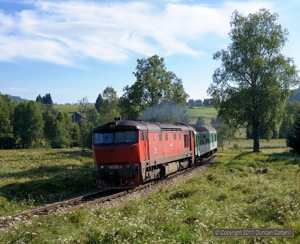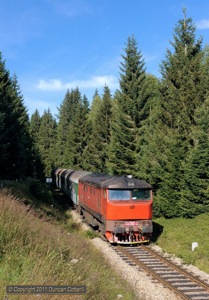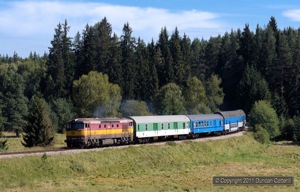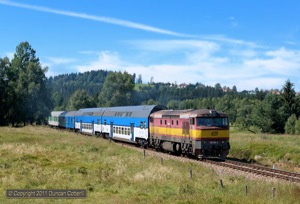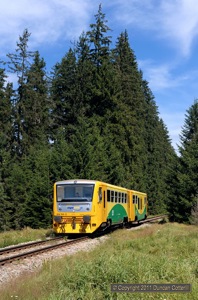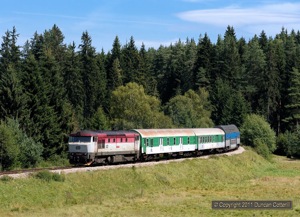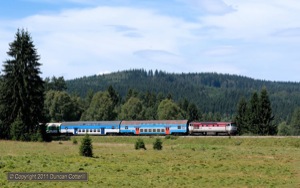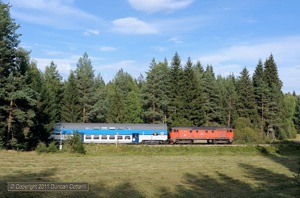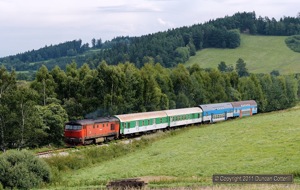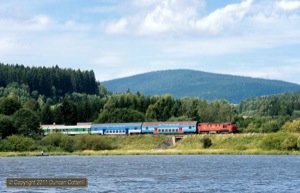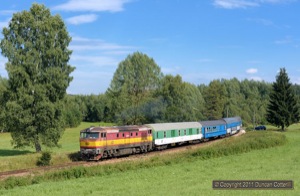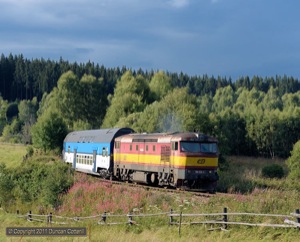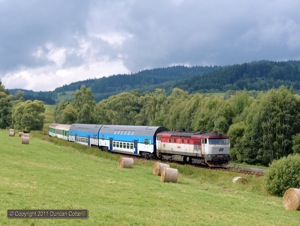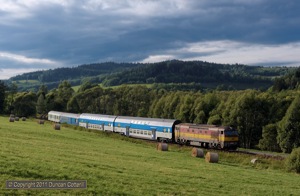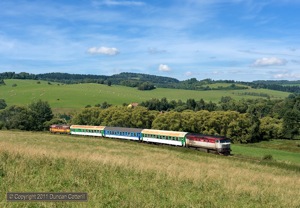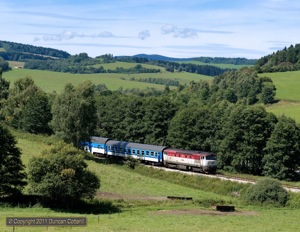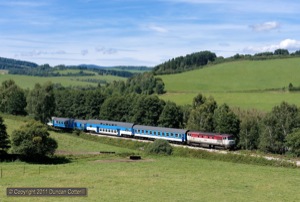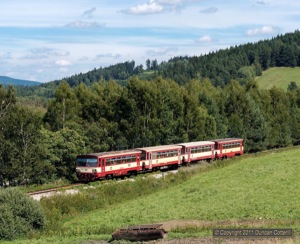Summer in the Sumava
10 - 14 August 2011
Report by Duncan Cotterill
Introduction
With the iconic class 749 diesels due to lose all their booked work in December 2011, a return visit to photograph the class at work on the Ceske Budejovice to Nove Udoli line was a must. There aren’t many loco hauled trains but that’s made up for by the glorious scenery of the Sumava (or Bohemian Forest), an upland area in the south-west of the Czech Republic, bordering on Austria and Germany. I spent five days on the line, from Wednesday 10 to Sunday 14 August 2011.
This section of the report summarises what was seen. For train by train details with loco numbers etc, go to the Day by Day pages.
The Line
The Ceske Budejovice to Nove Udoli line is a long rural railway, serving a number of small towns and villages as it winds its way across the hilly country west of Ceske Budejovice. Like many lines in the Czech Republic, it was built with an eye on costs, with plenty of tight curves and steep gradients and an almost total absence of significant civil engineering works, despite the nature of the landscape it runs through.
One of the towns served is Cesky Krumlov, an architectural gem with fine buildings dating back as far the 13th Century and a UNESCO World Heritage Site. Further west the line runs along the north shore of the huge Lipno Reservoir, the nearest the Czech Republic has to a coastline, and then enters the Sumava National Park, an area of outstanding natural beauty where the infant Vltava River flows through glorious upland scenery. As a result, the line carries a healthy volume of tourist traffic, particularly cyclists and hikers, and particularly in summer.
The line opened from Ceske Budejovice to Kajov, just west of Cesky Krumlov, in November 1891, and to Pernek na Sumave, a short distance east of Nova Pec, in July 1892. The section from Pernek to Haidmühle, just across the German border from Nove Udoli, was opened in June 1910, as was the connection from Cerny Kriz to Volary. Volary was already served by lines from Cicenice and Strakonice by then. By the end of 1910 Haidmühle was also connected through to Passau via Waldkirchen and Kaltenek, completing the network of lines in the area.
A new section of line from Cerna v Posumave to Nova Pec was opened in 1958, bypassing the area soon to be flooded by the damming of the Vltava and the formation of the Lipno Reservoir.
The current terminus at Nove Udoli is literally a few yards from the German border and the line across to Haidmühle was a victim of the Cold War, closing in 1948. At the same time all traffic south of Stozec ceased. Passenger services as far as Nove Udoli were resumed after the Velvet revolution in 1990. On the German side of the border, Haidmühle lost its passenger services in 1963 and the line towards Passau closed altogether in 1975.
Passenger Services
The passenger service has changed since my previous visit in August 2009 and now runs to a regular interval pattern. There are no through services from Praha any more, just local passengers stopping at all stations. In summer the trains run every two hours from Ceske Budejovice to Cerny Kriz with most continuing the last few km to Nove Udoli. A few services, early or late in the day, reverse at Cerny Kriz and go north a few km to Volary instead.
Crossing points are now standardized with trains crossing at Cesky Krumlov and Horni Plana. There is also a connection at Cerny Kriz with the two-hourly Nove Udoli – Cicenice service via Volary and Prachatice.
During the summer, three pairs of trains are booked for loco haulage by class 749 diesels. These services depart Ceske Budejovice at 08:07, 10:07 and 14:07 and return from Nove Udoli at 11:17, 13:17 and 17:17. In addition, the trains at 06:07 from Ceske Budejovice and 09:17 from Nove Udoli were 749 hauled during my visit. Three different locos were used each day with one loco working the 06:07 and 14:07 from Ceske Budejovice and the 09:17 and 17:17 back, a second loco on the 08:07 and 11:17 and the third on the 10:07 and 13:17. The 06:07 and 09:17 were formed of three single deck coaches but the other trains were usually formed of two single deckers and two double deckers. All other services are worked by 4-wheel railbuses of classes 809, 810 or 814.
Five different class 749s were seen on passenger services during my visit but most trains were hauled by red and yellow 749.100, orange 749.252 and red and grey 749.256. Red, white and blue 749.051 put in an appearance on the Wednesday and red and grey 749.254 was only seen on the Sunday. 749.100 failed while working the 06:07 from CB westwards on Sunday morning and 749.254 was sent from Ceske Budejovice, light engine, to rescue it. As a result, the 10:07 was worked by an 810 instead of being loco hauled. Everything else seen during the trip was worked by the booked traction.
Outside the summer season, which runs from 1 May to 1 October this year, all services are worked by railbuses and there are some gaps in the service, particularly at weekends and particularly at the west end of the line.
Freight Traffic
Freight traffic is fairly sparse on the line but there are a few workings. I don’t have any up to date times but what ran didn’t seem much different to the 2009 plan. The west end of the line is served by a Mondays, Wednesdays and Fridays only train from Volary to Kajov, worked by a CD Cargo class 751 outstationed at Volary. The train leaves Volary around 06:00 in the morning and gets to Kajov mid-morning. I saw it once this trip, arriving at Kajov just before 10:00, about an hour earlier than it was booked to arrive in 2009. The return working left Kajov around 12:10, not too different to its official 2009 timing of 12:19. Timber appears to be the main traffic at the west end of the line with a large timber yard located south of Nova Pec, at the end of a short branch, providing a good proportion of the traffic.
Kajov handles a significant volume of freight with grain loaded in sidings adjacent to the west end of the station and very steeply graded branch going south over the hill to the paper mill at Vetrni. During my visit Viamont’s 720.567 was employed shunting grain hoppers into position for loading. I didn’t see anything going to the paper mill but there had clearly been some recent traffic as the rails were fairly shiny.
The train from Volary meets a class 742 hauled working from Ceske Budejovice at Kajov, where they exchange traffic. This train is often double headed. On days when the Volary train doesn’t run, the 742(s) will sometimes continue west to Polecnice to service the timber sidings there. In 2009, this working was booked to run in the morning but on the Saturday I saw it heading west in the same 12:10 slot as the Volary train with the return working arriving back at Kajov around 14:20. Polecnice is on the edge of a large military reservation but I’ve never seen any military traffic going there by rail. The only deliveries during my stay appeared to be dropped from aircraft and went bang when they hit the ground.
Photography
As I said in my 2009 report, this is a difficult line to photograph but it’s very rewarding when you do get a good shot. With four loco hauled passengers each way to photograph this year, there are more opportunities than in 2009 but the timing of the trains is less than ideal. Most trains run in the morning but the best shots are in the afternoon and many are on the difficult to access section through the Sumava National Park where motor vehicles are banned. The only option is to take a long hike from Nova Pec, Pekna or Stozec, where there is access and parking. This makes it difficult to get the pics without setting off a long time in advance and committing yourself to a particular shot, not the ideal situation in rapidly changing weather where the mobility that a car offers is very useful. You can save yourself part of the walk by taking the train to one of the stations in the National Park but with two hour gaps between services it’s not a particularly practical way of getting about.
The best locations for morning trains are at the far end of the line, between Stozec and Nove Udoli. This section was a revelation for me as I hadn’t seen any good shots taken beyond Cerny Kriz before I left home. Finding a few good morning positions here was a real bonus. On the other hand, I left home with a list of shots I wanted to get and returned home having managed to take very few of them in decent light.
Horice na Sumave also offers a number of good locations from mid-morning onwards with the shots east of the station on from mid morning until early afternoon and those north of the station best from early afternoon through to sunset.
Logistics
I flew from Heathrow to Praha and back with British Airways, my first flights with them since before the cabin crew dispute. In Praha I picked up a hire car from Hertz, booked through Holiday Autos, and stayed at the 4* Hotel Albatros in Prachatice, booked through Booking.com. The big advantage in staying at the Albatros, apart from 4* comfort at a very reasonable price of around 750CZK per night, was the early breakfast that a business orientated hotel offers. This more than outweighed the distance I had to drive to reach the nearest locations.
Comment and Conclusions
As trips go, it wasn’t the best with poor weather hampering my efforts on three days and the service falling apart following a loco failure on a fourth day. That left one really good day, which I spent between Cerny Kriz and Nove Udoli, and a few shots picked up around Horice na Sumave during breaks in the weather on the other days. Not a disaster by any means but there are still so many shots to do. It looks like I’ll have to try to go back before the summer service finishes at the end of September. Next year will probably be too late.
